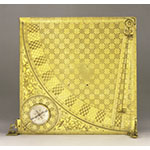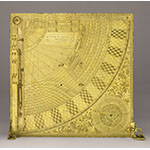"Universal" quadrant, i.e., suitable for performing mathematical, astronomical, astrological, and military operations. Made by Tobias Volckmer. Consists of a square engraved on both sides. Not only is the ornamentation refined, but the lines are etched with high precision, yielding reliable results within a modest margin of error. The main feature of the front side is the sine grid or reduction quadrant for determining sines and cosines. The graduated arc displays a nonius for dividing each degree into five minutes. On the upper corner are hinged two graduated vanes in the manner of compasses. One is fitted with sights. In the opposite corner is a removable magnetic compass showing the difference between the geographic north and the magnetic north. The back of the compass carries an astrolabe tympanum. The compass lid bears a sundial on one side and a moon dial on the other. The windrose is engraved on the instrument plate under the compass. The back of the instrument carries two Stöffler quadrants (named after their inventor, Johann Stöffler), a band of markings for military use, another for astronomical use, the degree scale, a plumb bob, and a disk with an index, called Signore dell'hore ineguali [Lord of the unequal hours], constituting the astrological calendar. Brought to Florence from Germany by Prince Mattias de' Medici in the first half of the seventeenth century.











